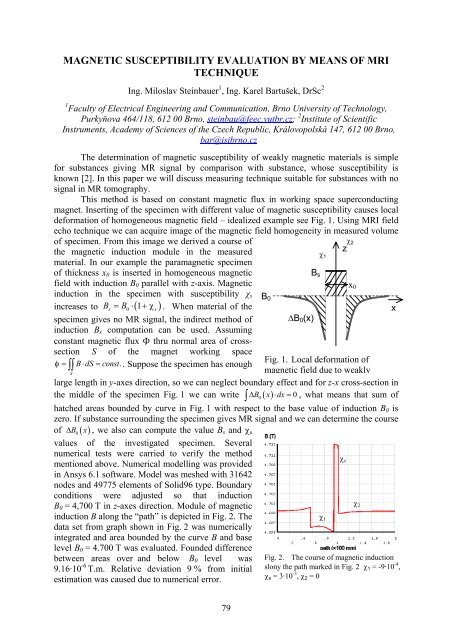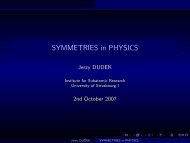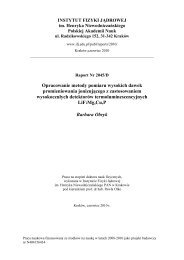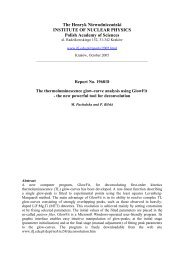Report No xxxx - Instytut Fizyki JÄ drowej PAN
Report No xxxx - Instytut Fizyki JÄ drowej PAN
Report No xxxx - Instytut Fizyki JÄ drowej PAN
You also want an ePaper? Increase the reach of your titles
YUMPU automatically turns print PDFs into web optimized ePapers that Google loves.
MAGNETIC SUSCEPTIBILITY EVALUATION BY MEANS OF MRI<br />
TECHNIQUE<br />
Ing. Miloslav Steinbauer 1 , Ing. Karel Bartušek, DrSc 2<br />
1 Faculty of Electrical Engineering and Communication, Brno University of Technology,<br />
Purkyňova 464/118, 612 00 Brno, steinbau@feec.vutbr.cz; 2 Institute of Scientific<br />
Instruments, Academy of Sciences of the Czech Republic, Královopolská 147, 612 00 Brno,<br />
bar@isibrno.cz<br />
The determination of magnetic susceptibility of weakly magnetic materials is simple<br />
for substances giving MR signal by comparison with substance, whose susceptibility is<br />
known [2]. In this paper we will discuss measuring technique suitable for substances with no<br />
signal in MR tomography.<br />
This method is based on constant magnetic flux in working space superconducting<br />
magnet. Inserting of the specimen with different value of magnetic susceptibility causes local<br />
deformation of homogeneous magnetic field – idealized example see Fig. 1. Using MRI field<br />
echo technique we can acquire image of the magnetic field homogeneity in measured volume<br />
of specimen. From this image we derived a course of<br />
the magnetic induction module in the measured<br />
z χ 2<br />
χ 1<br />
material. In our example the paramagnetic specimen<br />
of thickness x 0 is inserted in homogeneous magnetic<br />
B s<br />
field with induction B 0 parallel with z-axis. Magnetic<br />
x 0<br />
induction in the specimen with susceptibility χ s B 0<br />
increases to Bs<br />
= B0 ⋅ ( 1+<br />
χs)<br />
. When material of the<br />
x<br />
specimen gives no MR signal, the indirect method of ∆B 0 (x)<br />
induction Bs computation can be used. Assuming<br />
constant magnetic flux Φ thru normal area of crosssection<br />
S of the magnet working space<br />
φ = B ⋅dS<br />
=const.<br />
Fig. 1. Local deformation of<br />
∫∫<br />
. Suppose the specimen has enough<br />
S<br />
magnetic field due to weakly<br />
large length in y-axes direction, so we can neglect boundary effect and for z-x cross-section in<br />
the middle of the specimen Fig. 1 we can write ∫ ∆ B0 ( x)<br />
⋅ dx = 0 , what means that sum of<br />
hatched areas bounded by curve in Fig. 1 with respect to the base value of induction B0 is<br />
zero. If substance surrounding the specimen gives MR signal and we can determine the course<br />
of ∆B0<br />
( x)<br />
, we also can compute the value B s and χ s<br />
values of the investigated specimen. Several<br />
numerical tests were carried to verify the method<br />
χ s<br />
mentioned above. Numerical modelling was provided<br />
in Ansys 6.1 software. Model was meshed with 31642<br />
nodes and 49775 elements of Solid96 type. Boundary<br />
conditions were adjusted so that induction<br />
B 0 = 4,700 T in z-axes direction. Module of magnetic<br />
χ 2<br />
induction B along the “path” is depicted in Fig. 2. The<br />
χ 1<br />
data set from graph shown in Fig. 2 was numerically<br />
integrated and area bounded by the curve B and base<br />
level B 0 = 4.700 T was evaluated. Founded difference<br />
between areas over and below B 0 level was Fig. 2. The course of magnetic induction<br />
9.16·10 -6 T.m. Relative deviation 9 % from initial slony the path marked in Fig. 2 χ 1 = -9·10 -4 ,<br />
estimation was caused due to numerical error.<br />
χ s = 3·10 -3 , χ 2 = 0<br />
79

















